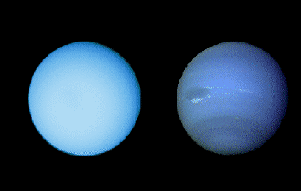

|
Astronomy 161:
An Introduction to Solar System Astronomy
Prof. Richard Pogge, MTWThF 9:30
|
Lecture 38:
Uranus & Neptune

Key Ideas:
Uranus & Neptune are the outermost of the Jovian planets.
- Nearly identical structure & composition.
Uranus:
- Lacks internal heat & so nearly featureless
- Axis is tilted by 90º, giving extreme seasons.
Neptune:
- Has internal heat & an active atmosphere
Comparison of the Jovian Planets
Orbits of Uranus & Neptune
- Uranus
- Semi-Major Axis: a = 19.2 AU
- Orbital Period: P = 84 years
- Eccentricity: e = 0.05
- Inclination: i = 0.8°
- Neptune
- Semi-Major Axis: a = 30.1 AU
- Orbital Period: P = 165 years
- Eccentricity: e = 0.01
- Inclination: i = 1.8°
Properties of Uranus & Neptune
- Uranus
- Equatorial Radius: R = 25,559 km (4.01 REarth)
- Mass: M = 14.5 MEarth
- Rotation Period: 17h 14m
- Axis Tilt: 97.9°!
- 27 moons, and thin, dark rings
- Neptune
- Equatorial Radius: R = 24,766 km (3.88 REarth)
- Mass: M = 17.1 MEarth
- Rotation Period: 16h 07m
- Axis Tilt: 29.6°
- 13 Moons and very dark, uneven rings and ring arcs.
Spacecraft studies
Voyager 2 flew by Uranus & Neptune:
- Uranus: January 1986
- Neptune: August 1989
Both have been extensively studied using the Hubble Space
Telescope:
- Long-term monitoring of atmospheric weather patterns.
- Infrared imaging studies of their atmospheres, rings, and
moons.
New studies are being enabled by the use of adaptive optics to
"detwinkle" the atmosphere of the Earth and provide views of Hubble-type
clarity from the ground.
Uranus & Neptune the Twins
Uranus & Neptune are near twins:
- Nearly identical sizes and internal structures.
Both appear bluish/green in color:
- Sunlight passes through an outer haze layer and bounces
off the cloud tops below.
- The haze is rich in methane, which strongly absorbs red
& orange light, letting blue & green light pass
through.
- Added factor is scattering in the haze layer.
Interiors of Uranus & Neptune
The interior structures of both are very similar:
- Atmosphere is of molecular hydrogen (H2),
Helium (He) & methane (CH4).
- Thick, slushy mantle of water, ammonia & methane
ices.
- Rocky cores about the size of the Earth.
Both lack the deep metallic hydrogen mantles found on Jupiter
& Saturn because of their smaller size (pressure never gets
high enough inside).
Uranus' Atmosphere
Uranus appears as a virtually featureless hazy blue ball.
- The reason is a lack of internal heat, unlike the other
Jovian planets.
- Clouds on Uranus are cold and don't billow up above
the top haze layer.
- Results in a generally uniform appearance.
Occasional clouds/storms seen in the infrared with the Hubble
Space Telescope.
Neptune's Atmosphere
Neptune, like Jupiter & Saturn, radiates about 2.7x as
much energy as it receives from the Sun.
- This internal energy gives Neptune an active, dynamic
atmosphere:
- Dark belts and bright clouds of methane ice.
- Dark oval cyclonic storms.
- Great Dark Spot - a large storm that appeared in the
mid-1980s then vanished by 1995.
Uranus' Extreme Seasons
The rotation axis of Uranus is tilted ~98°
- Uranus is lying on its side in its orbital plane.
Get extreme seasonal variations driven by uneven heating
between hemispheres:
- 1985: North pole in full sunlight, south pole in
total darkness.
- 2006: Sun on the equator, sunset at the north pole
starts a 42 year night, sunrise at south pole
- 2027: South pole in full sunlight, north is dark.
Such extreme seasonal variations may help account for Uranus'
lack of weather (the strong hemispheric difference may interfere
with the processes in bands and zones that are seen on the other
Jovian planets).
The Moons of Uranus & Neptune
Uranus has 27 moons:
- None are large enough to be "giant moons".
- 5 brightest are icy, spherical moons: Miranda, Ariel,
Umbriel, Titania, & Oberon
- Remaining 22 are tiny, irregular bodies.
- Named for characters in Pope & Shakespeare.
Neptune has 13 moons:
- 1 giant moon: Triton, a very cold icy moon that
orbits retrograde around Neptune.
- Remaining 12 are tiny, irregular bodies.
We will take a closer look at Triton along side Pluto and
Charon which it closely resembles in its properties.
Comparison of the Jovian Planets
Jupiter & Saturn:
- Large planets, 318 MEarth & 96 MEarth.
- Dense, deep metallic hydrogen mantles
- Dense, rocky cores of 10-15 MEarth
Uranus & Neptune:
- Similar size & mass (15 & 17 MEarth)
- Slushy semi-liquid water & methane mantles
- Rocky cores of ~1 MEarth.
Magnetic Fields
All Jovian planets have strong magnetic fields
- Jupiter's is strongest by far
- Saturn, Uranus, & Neptune have magnetic fields of
similar strength & extent.
- The magnetic fields provide the best way to measure
the rotation periods of the Jovian planets.
Uranus & Neptune have off-center fields:
- Magnetic & Rotation axes are very misaligned (59°
for Uranus, 47° for Neptune).
- Fields are off-center of the planets (30% for Uranus, 55%
for Neptune).
Nobody knows why, though a few ideas are being worked on.
Readings in Universe: Chapter 16, sections
16-1 through 16-5
Return to [
Unit 6 Index
|
Astronomy 161 Main Page
]
Updated: 2006 November 8
Copyright © Richard W. Pogge,
All Rights Reserved.
